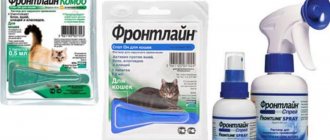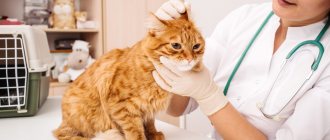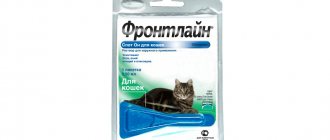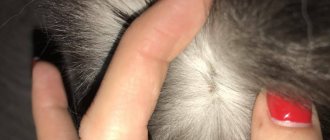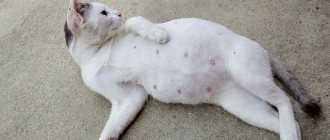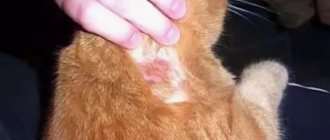Flea dermatitis is the most common disease among other types of this pathology. It occurs not only in street cats, but also in domestic cats. This disease requires timely diagnosis and treatment. This is the only way to prevent dangerous consequences for your pet’s health.
- 2 Types and symptoms of the disease
- 3 How to identify pathology and distinguish it from others
- 4 Ways to eliminate the disease
4.1 First stage: eliminating fleas
4.1.1 How to properly treat an animal for fleas - video
What do fleas look like on cats?
Fleas are wingless brown insects with 3 pairs of legs, the last of which is better developed than the others and is used for pushing off the surface when jumping, the length of which can reach 1.5 meters. Their body is flattened laterally, its length is 2–2.5 mm.
The flea has a laterally flattened body and three pairs of legs; no wings
The flea is protected from external influences by a chitinous shell, on which there are multiple spines and outgrowths that help it stay on the surface of the skin and fur. The parasite has a piercing-sucking type of mouthparts.
The flea lives for about 2 years, and actively reproduces. Fleas lay eggs wherever they can, and the worm-like larvae that emerge from the eggs feed on dust, debris, and various contaminants. The larvae turn into pupae, which, under unfavorable external conditions, can remain viable in the external environment for up to 1 year. The entire development cycle of a flea under favorable conditions takes only 2–3 weeks.
Fleas are highly mobile and tend to change hosts. It is extremely important that the majority of fleas live in the room where the cat is kept, while on the cat itself the number of parasites does not exceed 5–10% of the existing number.
Fleas are carriers of diseases:
- hemobartonellosis - infectious anemia of cats;
- tularemia - a natural focal infectious disease;
- helminthic infestations: dipilidia - parasitism of cucumber tapeworm;
- dipetalonematosis - parasitism of small roundworms - microfilariae. The disease occurs in Africa, South America, and southern Asia.
Ways of flea infection
Flea infestation occurs when:
- direct contact with infected relatives;
- through bedding, toys, and care items infested with fleas, their eggs and larvae;
- fleas can live in an apartment, periodically attacking a cat;
- A mother cat with fleas infects her kittens with them immediately after their birth.
If a mother cat has fleas, all her kittens become infected.
Reasons for the development of the disease
Fleas are year-round parasites that can live and breed anywhere. Those who live in basements and entrances of houses are especially dangerous. From there, on their own, on the folds of clothing or on the soles of shoes, they get into apartments and jump on pets. Thus, most often a cat becomes infected with flea dermatitis in the following ways:
- in the entrance, if he accidentally jumps out there; - through a person, since fleas can get into the apartment on his clothes and shoes; - through a dog, since it can easily bring parasites home from the street after a walk; - during self-walking.
Read more about the dangers of self-walking: Self-walking - when freedom means death
This is why kittens that have never left the apartment are susceptible to flea dermatitis. Since flea dermatitis is caused by allergens from the saliva of parasites, the following are most susceptible to this disease:
- individuals prone to allergies; — kittens, since they have weak immunity; — weakened animals (sick); - representatives of some breeds (especially hairless); - older cats.
Causes of flea dermatitis in cats
Flea dermatitis is an inflammatory skin disease of allergic origin. It is based on the formation of hypersensitivity to flea bites, the saliva of which is a complex allergen. There are:
- Immediate hypersensitivity reactions occur when an allergen to which an antibody titer has already been developed is re-entered into the body. The meeting of the allergen and antibody occurs on the membrane of mast cells and causes the release of a large amount of biologically active substances (histamine, bradykinin, serotonin, heparin, reactive oxygen species). This type of reaction for flea dermatitis is manifested by the occurrence of: redness of the skin;
- skin itching;
- urticaria (the appearance of skin infiltrates accompanied by itching and redness of the skin). In some cases, these signs appear immediately after the very first flea bite, and we are talking about atopy - an altered type of immune system response that is inherited.
Flea dermatitis, fortunately, does not affect all cats that have been bitten by fleas, since flea bites do not cause an allergic restructuring of the immune system in all pets. Most often, with flea dermatitis in cats, delayed-type hypersensitivity reactions or a mixed type of reaction develop. The disease of flea dermatitis, as well as its exacerbations, is characterized by seasonality. When fleas live indoors, there is no seasonality of the disease in cats.
Video: flea dermatitis
Treatment
The only effective treatment will be to eliminate parasites and carry out a complete disinfestation of the premises. In this way, you can not only return the animal to a full life, but also prevent possible relapses. It is necessary to fight the disease as early as possible, otherwise the skin in places will become thick and begin to become rough, and the disease itself will become chronic.
Drops
These products are the safest. As a rule, emulsions with fipronil, permethrin or fenthion are prescribed. The preparations are applied to the skin of the withers so that the cat cannot lick it until it is completely absorbed. You can swim two days after applying the products.
Sprays
They contain organochlorine compounds. When applying sprays, you need to be careful not to harm the animal or yourself. Cats are wearing protective collars to prevent licking.
Shampoos
Helps soothe skin inflammation. They should be used with caution, strictly following the instructions. This is especially true for bathing kittens. The main component of shampoos is the insecticide permethrin.
Collars
The principle of operation is quite simple - scare and destroy. The products are impregnated with special preparations that repel fleas. A membrane that is invisible to the eye is formed near the neck. And those parasites that already live on the fur will be destroyed by a specific smell. The shelf life of one product is 4 weeks-6 months.
Collars are divided into several categories: depending on age (for adults, for kittens, for cats during pregnancy) and according to how they act (based on insecticides, aromatic oils and herbs, ultrasound). Used primarily for preventive purposes.
Antihistamines
Good for eliminating allergic reactions in humans, but not so effective for animals. Loratadine or its analogues will not be able to completely relieve a cat’s allergies. They act as aids.
Hormonal drugs
Doctors often prescribe prednisolone or its analogues. The course of treatment will be long, starting with large doses, all the time reducing them to the minimum. They have a good effect, flea dermatitis recedes. The dosage is selected individually. But they should be used only in extreme cases due to numerous side effects on all systems and organs.
Folk remedies
They do not replace traditional therapy, but are used as an addition to it. An effective recipe is: lavender, tea tree, cedar oil in equal quantities and soapy water. The resulting mixture is used to treat the skin before bathing and after water procedures.
Main manifestations of flea dermatitis in cats
The most common manifestations of flea dermatitis in cats are:
- miliary dermatitis - redness and multiple blisters (vesicles) appear on the skin, which, when opened, form small erosions. After the erosions dry out, numerous crusts appear. With a long course of the disease, the affected areas acquire a dark color - acanthosis nigricans develops. The fur thins and falls out. The disease is accompanied by unbearable skin itching; when scratching, infection occurs with secondary microbial flora;
- formation of foci of baldness in the absence of inflammatory manifestations;
- development of the eosinophilic granuloma complex - accumulations of eosinophils and lymphocytes in the lesions take part in the development of all its forms. Manifestations: eosinophilic granuloma - looks like: whitish nodules or tubercles on the oral mucosa;
- linear intradermal thickenings on the body.
- nausea;
- deterioration of the cat’s general condition;
- irritability;
Photo gallery: manifestations of flea dermatitis in cats
baldness is a characteristic sign of flea dermatitis
eosinophilic granulomas look like intradermal thickenings in the shape of a line; eosinophilic plaques can merge to form continuous eroded surfaces
acute dermatitis caused by an allergy to flea bites; miliary dermatitis is represented by small erosions and crusts on the skin
Additional Notes
As you can see, a seemingly harmless disease can do serious things. That’s why prevention is “our everything.” The simplest and most effective means of preventing flea infestation is a collar. Today there are dozens of varieties on the market, from a wide variety of companies. Don’t forget to change the collar on time, and your cat will be reliably protected from small bloodsuckers. Insecticidal drops and simple wormwood oil have also worked well, which also repels fleas well; you can use tar soap.
In addition, do not forget to clean the room more often, paying special attention to wet cleaning of the most remote corners of the apartment. In this case, it is very useful to add insecticidal preparations or simple chlorine bleaches in good concentrations to the water for washing floors. This way you are guaranteed to destroy all the larvae, and the flea population will not increase.
Diagnosis of flea dermatitis
The diagnosis is made based on:
- detection of typical skin manifestations with signs of flea infestation (the presence of fleas or their excrement on the cat’s skin);
- studying scrapings from a cat's skin;
- histological examination of a skin sample - in some cases, to clarify the nature of the disease;
- general blood test - an increase in the content of eosinophils is typical; when allergic dermatitis is complicated by secondary microbial flora, leukocytosis will appear; when infected from fleas with hemobartonellosis or helminths, hemoglobin will decrease;
- skin allergy tests - are necessary in cases where signs of flea parasitism are not visually determined in a cat. Fleas can bite a cat periodically, without parasitizing on it and living in the external environment;
- the presence of positive dynamics in the course of the disease after the use of drugs that destroy fleas.
A cat owner can suspect the presence of flea dermatitis on his own, but examination by a veterinarian is necessary, since there are diseases that have similar symptoms:
- mite damage: sarcoptic mange;
- notoedrosis;
- demodicosis
When a cat is infested with fleas, dark flea excrement is detected in the cat's fur.
Symptoms
The disease cannot remain undetected for long. The owner will quickly notice changes in his cat's behavior. The following symptoms are typical for flea dermatitis:
- excessive dryness of the epidermis;
- restless behavior (irritability, restlessness, fearfulness, meowing);
- loss of appetite;
- scratching on the skin;
- burning, itching;
- ulcers, fibrous nodules, swelling;
- The fur in the affected areas becomes thinner, breaks, or falls out.
The skin is usually hot to the touch. Fleas and their waste products (dark-colored feces) can be visible to the naked eye. External changes most often affect the upper thighs and torso, and the root of the tail.
Sometimes, during a chronic process, a bacterial or yeast infection may occur. As a rule, in these cases, a not very pleasant smell appears from the cat.
It should be noted that similar symptoms may accompany some other diseases. Therefore, before starting treatment, it is better to seek help from a specialist.
Treatment of flea dermatitis in cats
For the treatment of flea dermatitis, the following are used:
- Corticosteroids - in order to suppress the reaction of allergic inflammation, they are effective in 90% of cases of systemic use: Prednisolone;
- Dexamethasone;
- Hydrocortisone.
- Tavegil;
- Sinulox;
- Stronghold;
- Advantage - both effectively destroys and repels parasites, this is a rare combination of properties;
- calcium chloride;
- Feliderm;
- Rolf Club;
- Levomekol ointment;
Photo gallery: drugs for the treatment of flea dermatitis
Prednisolone quickly relieves skin itching and reduces inflammation in flea dermatitis
Tsiprovet is prescribed for a short course of 5 days in the presence of bacterial complications
Tavegil suppresses the release of histamine from mast cells in immediate allergic reactions
The uniqueness of Advantage lies in the combination of insecticidal and repellent effects
Stronghold effectively destroys fleas at all phases of their development
Table: products used for external flea treatment
| A drug | Compound | Operating principle | Price, rub |
| Stronghold, drops on the withers | Selamectin | Destroys eggs, larvae and adult forms of external parasites, as well as roundworms. Apply once a month. Possible during pregnancy and nursing kittens. Not allowed for kittens under 6 weeks of age. | 386 |
| Frontline Spray | Fipronil | Destroys external parasites and ixodid ticks. Protects against fleas for up to 40 days. You should not bathe 2 days before using the spray, or 2 days after. Suitable for pregnant and lactating cats, as well as kittens from 2 days of age | 881 for 100 ml |
| Leopard, drops on the withers |
| Destroys external parasites and ixodid ticks. Protects against fleas for up to 1–2 months. Cannot be used during pregnancy, lactation, or in kittens under 8 weeks | 176 |
| Green Fort | Citronella essential oil | Repels fleas and other external parasites. Can be used in pregnant and lactating cats, and in kittens from 4 weeks of age. Highly safe product | 375 |
Means used internally
Flea control agents used internally:
- Comfortis tablets - the active ingredient is spinosad, which causes paralysis and death of fleas. The effect begins within half an hour after taking the tablet and lasts for 1 month. Not applicable during: pregnancy;
- lactation;
- under 14 weeks of age in kittens;
- epilepsy;
- individual hypersensitivity to the components of the product.
Traditional medicine
For flea dermatitis, the use of folk remedies is possible, but it is better to do this in combination with veterinary remedies to destroy skin parasites, as well as taking medications prescribed by a veterinarian. Folk remedies will improve the condition of the skin and coat and help get rid of some parasites, but it will not be possible to cure flea dermatitis using only folk remedies.
Traditional methods include bathing your pet in herbal infusions:
- capable of destroying a small number of parasites: wormwood;
- tansy.
- calendula;
Infusions for bathing are prepared:
- Take 100 g of dry herb.
- Add 2 liters of boiling water.
- Leave for 30 minutes in a water bath.
- Leave for 1 hour after removing from the water bath.
- Strain the infusion.
- Add water to the required volume for bathing.
To repel parasites, you can use a bag of dried wormwood or tansy grass, tied to the cat's collar.
Photo gallery: traditional medicine for the treatment of flea dermatitis:
You can wash your cat with tansy infusion to reduce the number of parasites
dry wormwood in a bag attached to a cat's collar can repel fleas
calendula infusion has a disinfecting effect on skin lesions and also reduces inflammation
Features when treating pregnant cats and kittens
The development of flea dermatitis in pregnant cats is very dangerous, since the severe disease requires the use of corticosteroids and antibiotics, which are contraindicated during pregnancy. In small kittens, flea dermatitis occurs extremely rarely before the age of 6 months, is represented by immediate reactions and usually indicates existing atopy, the extreme manifestation of which can be anaphylactic shock, which poses a direct threat to the life of the kitten. It is important to prevent flea attacks on pregnant cats and small kittens; if there is a flea infestation, it is necessary to treat the mother cat and babies with Frontline spray, which is approved for use in pregnant and lactating cats, as well as in kittens from 2 days of age.
Traditional methods of treating allergies to flea bites
In case of mild disease, traditional methods can be used to eliminate ectoparasites.
- Use of needles for bedding . Fleas are repelled by this smell, so it is advisable to replace your pet’s sleeping place with a mattress stuffed with pine needles.
- Salt . Pour half a pack of salt into a bowl of warm water and bathe the animal in this solution. As a rule, several such procedures are necessary to achieve maximum results. It is important to ensure that water does not get into your cat's eyes. Such procedures cannot be performed if there are open wounds on the animal’s body.
- Garlic . The smell of this vegetable is known to repel many types of parasites, including fleas. To prepare the mixture, you need to pass 2-3 slices through a special press, add half a glass of warm water and let it brew for 6-10 hours. Gently rub the resulting solution into your pet’s skin and allow to dry.
- Essential oils with the scent of lavender and cedar . To do this, make a medicinal solution: add 3 drops of lavender and cedar oil to 0.5 liters of warm water. Then shake well and spray over the cat's fur using a spray bottle. This procedure should be carried out 2-3 times a day until all parasites disappear.
How to rid your cat of fleas and prevent their appearance
It is necessary to act on fleas in a comprehensive manner, since fleas at different stages of development and in large quantities are kept in the room where an infected cat lives:
- All domestic animals with fur are subjected to simultaneous treatment for external parasites;
- in the future, animal protection is achieved by regular preventive use of insecticides, as well as repellents in any forms convenient for the owner for all pets;
- regular repeated wet cleaning of the floor and horizontal surfaces is carried out using solutions of Neostomozan or Ecocide;
- upholstered furniture, carpets, car interiors, cat beds are regularly vacuumed, reliably getting rid of the contents of the vacuum cleaner (it is better to burn), and you can also use a steam generator;
- prevent contact between pets and stray animals;
- Wash your hands thoroughly after contact with other people's pets to prevent the transfer of parasites to your cat.
Regular flea treatment with veterinary insecticides is used both for the treatment of flea dermatitis and for its prevention
Prevention measures
Prevention rules:
- Clean your pet's bedding regularly.
- Periodically bathe your pet using anti-flea shampoo.
- To prevent infection, use drops on the withers against fleas and helminths once every six months.
- If your pet often goes outside, put an anti-flea collar on it.
- Avoid exposing your indoor cat to outdoor animals.
- Regularly carry out wet cleaning using bleach.
- If there are cockroaches in the house, be sure to remove them.
- Keep shoes out of reach of your pet.
Anti-flea collar helps prevent fleas and ticks
If your animal suddenly develops itching, be sure to show it to a veterinarian. Using special optical equipment, the doctor will be able to determine the presence of even a small amount of parasites.




